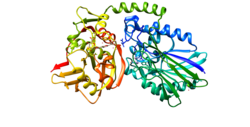Un déficit génétique en CD73 entraîne un syndrome comportant une calcification importante des artères[7]. Ce déficit entraîne une augmentation compensatoire du TNAP qui transforme le pyrophosphate en phosphate. Le déficit en pyrophosphate entraîne la levée de l'inhibition du processus de calcification[8].
- ↑ a b et c GRCh38: Ensembl release 89: ENSG00000135318 - Ensembl, May 2017
- ↑ a b et c GRCm38: Ensembl release 89: ENSMUSG00000032420 - Ensembl, May 2017
- ↑ « Publications PubMed pour l'Homme », sur National Center for Biotechnology Information, U.S. National Library of Medicine
- ↑ « Publications PubMed pour la Souris », sur National Center for Biotechnology Information, U.S. National Library of Medicine
- ↑ Thompson LF, Eltzschig HK, Ibla JC, Van De Wiele CJ, Resta R, Morote-Garcia JC, Colgan SP, Crucial role for ecto-5’-nucleotidase (CD73) in vascular leakage during hypoxia, J Exp Med, 2004;200:1395–1405
- ↑ Eckle T, Füllbier L, Wehrmann M, Khoury J, Mittelbronn M, Ibla J, Rosenberger P, Eltzschig HK, Identification of ectonucleotidases CD39 and CD73 in innate protection during acute lung injury, J Immunol, 2007;178:8127–8137
- ↑ St Hilaire C, Ziegler SG, Markello TC et al. NT5E mutations and arterial calcifications, N Engl J Med, 2011;364:432-442
- ↑ Jin H, St Hilaire C, Huang Y et al. Increased activity of TNAP compensates for reduced adenosine production and promotes ectopic calcification in the genetic disease ACDC, Sci Signal, 2016;9:ra121-ra121





